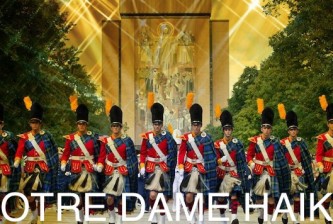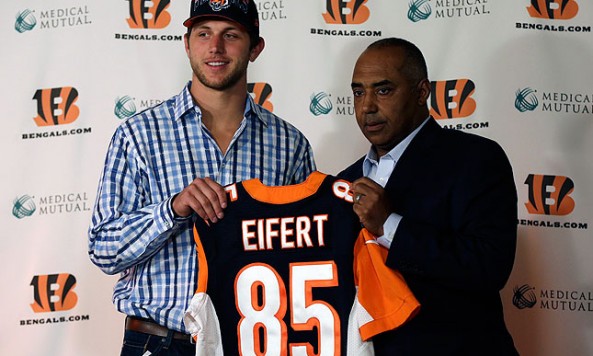When the Cincinnati Bengals selected Tyler Eifert as the 21st overall pick in the 2013 NFL draft, he became the first of six tight ends taken in the top 100 picks. He also became the second tight end the Bengals have drafted in the first round in recent years, joining 2010 first-rounder Jermaine Gresham.
The NFL has long been known as a copycat league. After seeing the success of the Patriots' offense with tight ends Rob Gronkowski and Aaron Hernandez, it's no wonder teams like the Bengals are stockpiling tight ends. Multiple tight end offenses are on the rise in the NFL, and it will be interesting to see if the Irish continue utilizing multiple tight end formations as frequently in Eifert's absence.
Why are multiple tight end offenses on the rise?
As I have previously written, using a multiple tight end offense can create mismatches not easily countered with changes in personnel or formation. Linebackers are generally too slow to cover tight ends, and defensive backs generally lack the size and physicality to cover them or take on blocks. As a result, defensive coordinators are constantly facing a double bind. On one hand, if they use base personnel (e.g., 4-3 or 3-4), the defense is vulnerable to the pass. On the other hand, if they substitute to a nickel package, the defense is vulnerable to the run.
In addition to creating mismatches, a multiple tight end offense can disguise the offense's intention (whether run or pass) and limit the need for substitution. If the tight ends are legitimate blockers and receiving threats, an offense can line up in or motion to just about any formation imaginable. According to Redskins head coach Mike Shanahan, one of the early adopters of a multiple tight end offense, “[w]hat a couple of tight ends enable you to do is present a different package to the defense . . . . They’re not sure if you’re in a three wide receiver set, four wide receiver set, two tight ends, or three tight ends. The more you can do, the more you can keep defenses off balance.”
A look at the Irish using multiple tight ends
Aside from Stanford or Alabama, very few college teams used multiple tight end formations as often as Notre Dame last season. Below is an example of the Irish using multiple tight ends (specifically Eifert) to exploit the Navy defense in the red zone.
Facing third-and-goal from the Navy five yard line, the Irish lined up with 13 personnel, i.e., one running back and three tight ends. Eifert (1) is isolated to the boundary against cornerback Parrish Gaines, while Ben Koyack (2), Troy Niklas (3), Theo Riddick and Davaris Daniels lined up to the field. Notre Dame often used this type of 4×1 formation to isolate Eifert because the defense has to respect the offensive numbers to the opposite side of the field.
The Irish use a seven-man protection with Niklas and Koyack staying in to block. Golson immediately recognizes man coverage on Eifert and throws the fade. When facing man coverage, the coaching staff instructs the quarterbacks to throw it to the best receiver or to the receiver guarded by the worst defender.
Although Gaines is larger than most corners at 6-2/196 lbs, he's no match for the 6-6/242 lb Eifert. Eifert used his size and strength to boxout Gaines. Neither the linebacker nor the safety could rotate in time to make a difference. Touchdown Irish.
Conclusion
The premium that NFL teams are placing on tight ends bodes well for "Tight End U." If Brian Kelly and Chuck Martin continue utilizing tight ends the way they have in recent years, the Irish should have no problem reeling in elite tight ends and developing them into All-Americans with bright NFL futures.



























